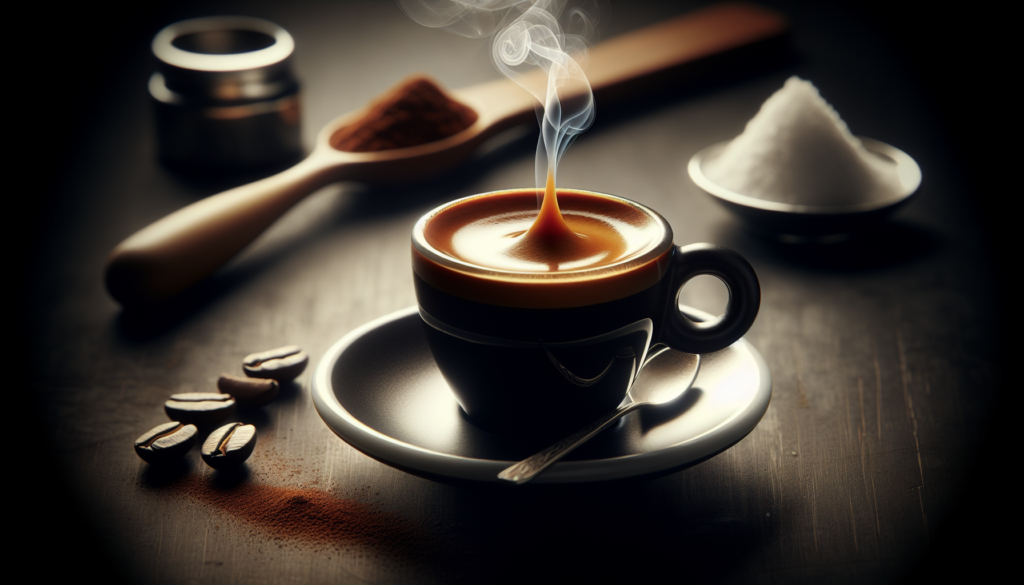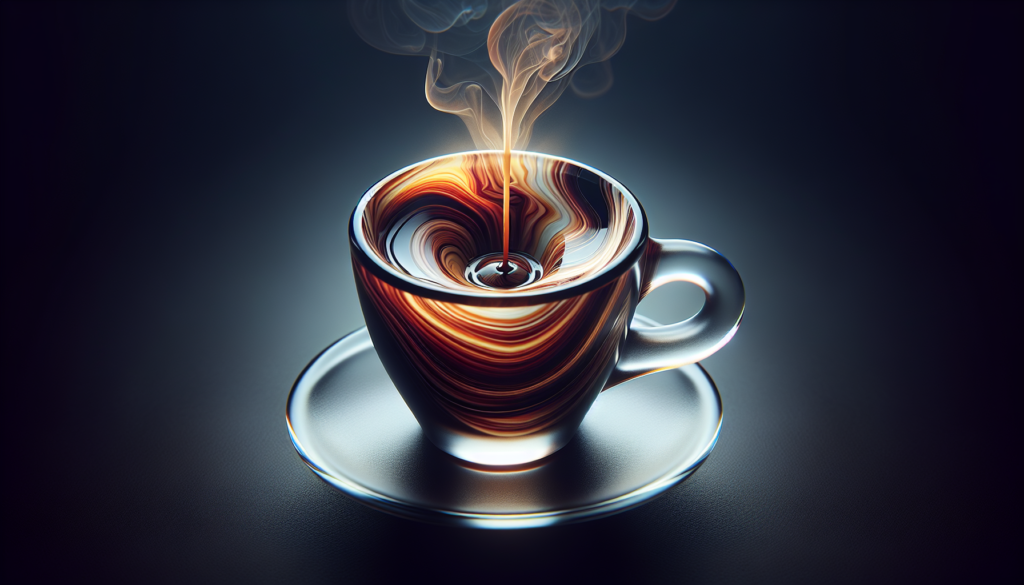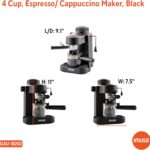So you’ve probably heard of espresso shots and you know they pack a punch, but have you ever wondered if an espresso shot is just strong coffee? Well, the answer might surprise you. While both espresso and regular coffee come from the same basic ingredient – coffee beans – the brewing methods and flavors are distinct. In fact, espresso is made by forcing hot water through coffee grounds at a high pressure, resulting in a concentrated and intense flavor. So, the next time you reach for an espresso shot, remember that it’s not just strong coffee, but a unique and flavorful beverage in its own right.
Definition of Espresso
Espresso is a concentrated coffee beverage that is brewed using finely ground coffee beans and hot water. It is made by forcing pressurized hot water through a compact puck of coffee grounds, resulting in a strong and intense flavor. The term “espresso” comes from the Italian word for “express” or “fast,” reflecting the quick brewing time and the immediate enjoyment of this caffeine-packed drink.
Differences in Preparation
Grind Size
One key difference between espresso and regular coffee lies in the grind size of the coffee beans. Espresso requires a much finer grind than regular coffee. The finer grind allows for a higher surface area of the coffee grounds to be in contact with the water during the brewing process, resulting in a more concentrated flavor profile.
Brewing Time
The brewing time for espresso is significantly shorter than that of regular coffee. While coffee typically takes a few minutes to brew, espresso is prepared within seconds. The rapid brewing process extracts the flavors and compounds from the coffee grounds swiftly, contributing to the distinct taste and aroma of espresso.
Pressure
Another distinguishing factor in the preparation of espresso is the use of pressure. Espresso machines are equipped with a pump that exerts pressure to force water through the coffee grounds. The high pressure, typically around 9 bars, extracts the oils and solids from the coffee grounds, resulting in the rich and full-bodied espresso shot.
Water Temperature
The water temperature during espresso preparation is also critical to achieving the desired flavors. Ideally, the water should be around 195°F to 205°F (90°C to 96°C). The hot water interacts with the coffee grounds, causing the extraction of flavors while also maintaining the proper balance and avoiding bitterness.

Taste and Flavor
Espresso offers a unique taste and flavor profile that sets it apart from regular coffee. Due to the concentrated nature of the beverage, espresso tends to have a bold, robust, and intense flavor. The flavors can range from earthy and nutty to fruity and chocolatey, depending on the type of coffee beans used. The crema, a creamy and tan-colored layer that forms on top of a well-brewed shot of espresso, adds a smooth and velvety texture, enhancing the overall taste experience.
Caffeine Content
Contrary to popular belief, espresso does not necessarily contain more caffeine than regular coffee on a per-ounce basis. However, due to its concentrated nature, a serving of espresso typically contains less liquid than a cup of coffee. As a result, a standard espresso shot with 1.5 to 2 ounces of liquid may contain around 63 milligrams of caffeine, while an 8-ounce cup of brewed coffee can have anywhere from 95 to 165 milligrams of caffeine. Therefore, drinking a shot of espresso may give you a quick caffeine boost, but it might not provide as much caffeine as a regular-sized cup of coffee.

Serving Size
Espresso is traditionally served in small quantities, most commonly in 1 to 2-ounce shots. The small serving size is designed to be consumed quickly and enjoyed as a concentrated burst of flavor. Additionally, the small size allows for more control over the intensity of the drink and encourages sipping rather than leisurely savoring.
Popular Espresso Beverages
Cappuccino
Cappuccino is a beloved espresso-based beverage that combines equal parts espresso, steamed milk, and foam. The combination of the creamy foam, velvety steamed milk, and rich espresso creates a harmonious blend of flavors and textures. Cappuccinos are often topped with a sprinkle of cocoa or cinnamon for added indulgence. This classic Italian drink is a popular choice for those seeking a balance between the strength of espresso and the smoothness of milk.
Latte
A latte, also known as a café latte, features a shot of espresso combined with steamed milk. It is generally topped with a thin layer of foam and can be customized with flavorings such as vanilla, caramel, or hazelnut. Lattes offer a milder and creamier coffee experience compared to other espresso-based beverages, making them a popular choice for those who prefer a less intense flavor profile.
Americano
Americano is a coffee drink that consists of a shot or two of espresso diluted with hot water. This beverage offers a taste similar to regular drip coffee but with the intensity of espresso. It is often served black or with a dash of milk or cream. Americanos are favored by those who enjoy the boldness of espresso but desire a larger volume of liquid.
History and Origins
The invention of the espresso machine and subsequently, the creation of espresso, is attributed to Angelo Moriondo from Turin, Italy. In 1884, Moriondo patented his “apparatus for the instantaneous extraction of coffee beverage” which laid the foundation for modern espresso machines. Over the years, Italian inventors and baristas further refined the espresso brewing process, leading to the widespread popularity of espresso in Italy and beyond.
Cultural Significance
Italian Coffee Culture
Espresso holds a significant place in Italian coffee culture. In Italy, drinking espresso is not just about getting a quick caffeine fix; it is a social experience and an integral part of daily life. Italians often enjoy their espresso standing at the counter of a café, engaging in lively conversations with friends and colleagues. The coffee bar is a hub of social interaction and a symbol of Italian identity.
Espresso Culture in Other Countries
Throughout the years, espresso has gained popularity worldwide and has become a part of various cultures. In countries such as France, Spain, and Argentina, espresso is an essential part of the daily routine and is enjoyed with friends or as a midday pick-me-up. In the United States, espresso has been embraced as the foundation for a variety of specialty coffee beverages and is a staple in many coffee shops.
Health Benefits and Risks
Espresso, like any caffeinated beverage, has potential health benefits and risks. Consuming moderate amounts of espresso can provide a temporary energy boost, increased alertness, and improved cognitive function. It may also contain antioxidants and beneficial compounds that can contribute to overall wellbeing. However, excessive consumption can lead to negative effects such as sleep disturbances, increased heart rate, and digestive issues. It is essential to consume espresso in moderation and be mindful of individual caffeine sensitivity.
Conclusion
Espresso offers a unique and distinct coffee experience with its intense flavors, concentrated nature, and quick brewing process. Whether enjoyed as a shot on its own or incorporated into popular beverages like cappuccino and latte, espresso has become a beloved and integral part of coffee culture worldwide. From the bustling coffee bars of Italy to the cozy coffee shops of America, espresso continues to captivate coffee enthusiasts and provide a flavorful jolt of energy. So, the next time you’re in need of a quick pick-me-up, consider treating yourself to a delicious and invigorating shot of espresso.






